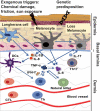Skin immunity and its dysregulation in atopic dermatitis, hidradenitis suppurativa and vitiligo
- PMID: 31905036
- PMCID: PMC7028161
- DOI: 10.1080/15384101.2019.1707455
Skin immunity and its dysregulation in atopic dermatitis, hidradenitis suppurativa and vitiligo
Abstract
While the epidermis is the frontline defense against infections and indeed, it is a peripheral lymphoid organ, the same immunological mechanisms may initiate and sustain pathological conditions. Indeed, a deregulated action against exogenous pathogens could activate a T cell response in atopic dermatitis, hidradenitis suppurativa and vitiligo. Atopic dermatitis (AD) is a chronic inflammatory skin condition with a complex pathophysiology. Although T helper 2 immunity dysregulation is thought to be the main cause of AD etiopathogenesis, the triggering mechanism is not well understood, and the treatment is often difficult. As the AD, hidradenitis suppurativa (HS) is a chronic inflammatory skin disease with a dramatic impact on the quality of life of the affected patients. The exact pathophysiology of HS is still unclear, but many evidences report a follicular obstruction and subsequent inflammation with TNF-α, interleukin (IL)-1β, IL-10, and IL-17 involvement. Vitiligo is an autoimmune epidermal disorder which consists of melanocytes destruction and skin depigmentation. Melanocytes destruction is mainly due to their increased oxidative-stress sensitivity with a consequent activation of innate first and adaptative immunity (CD8+ T cells) later. The understanding of the triggering mechanisms of AD, HS and Vitiligo is pivotal to outline novel therapies aimed at regaining the physiological immune homeostasis of healthy skin. The aim of this review is to provide new insight on the pathogenesis of these skin diseases and to highlight on the new therapeutic approaches adopted in the treatment of AD, HS and Vitiligo.
Keywords: Atopic dermatitis; hidradenitis suppurativa; vitiligo.
Figures



References
Publication types
MeSH terms
Substances
Grants and funding
LinkOut - more resources
Full Text Sources
Medical
Research Materials
